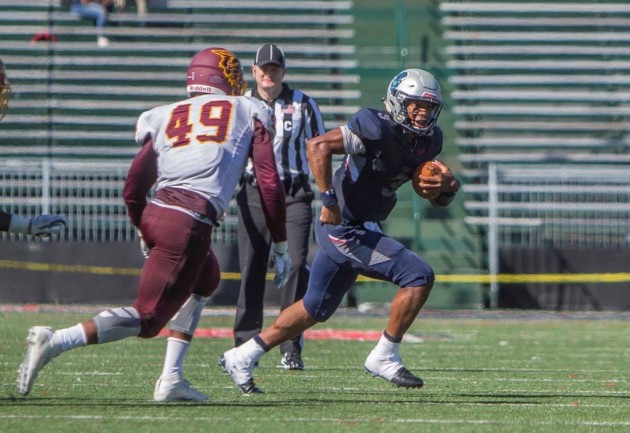A Look at the Professional History of African American Quarterbacks
This past Sunday, quarterbacks Donovan McNabb of the Philadelphia Eagles and Michael Vick of the Atlanta Falcons made history as they faced off in the NFL Championship Game at Lincoln Financial Field in Philadelphia.
Last Sunday’s match-up between the two of the best QBs in the National Football League (NFL) marked the first that two African American quarterbacks faced off against one another for a chance to go to the Super Bowl.
This is on the heels of their previous match-up in the Divisional Playoffs Round in 2002, when Vick and McNabb became the first two African American QBs to face each other in an NFL playoff game, according to an article from www.phillyburbs.com.
“Well the larger meaning is that we’ve kind of stepped over the negative stepping stone of people saying that an African American quarterbacks can’t lead his team to a Super Bowl,” McNabb said, told www.phillyburbs.com reporters.
“This is kind of the new generation of quarterbacks, guys that are able to do a little bit more than just sit back in the pocket and pass the ball. Things have changed and it’s going to be an exciting day on Sunday.”
The reason for the growing number of black quarterbacks in the NFL is largely due to the increase in opportunities as opposed to 20 years ago when nobody thought an African American could effectively perform in that position.
That all changed though in 1952. According to a press article from www.marlinbriscoefootball.com, Willie Thrower was the first African American to play quarterback in the NFL. He signed with the Bears in 1952 for $8,500 as a back-up to George Blanda. In his only performance on Oct. 18 1953, in relief of Blanda, Thrower went 3 of 8 passing for 27 yards and an interception in a 35-28 loss to the San Francisco 49ers.
According to an article from www.phillyburbs.com, Marlin Briscoe became the first modern day black quarterback for the Denver Broncos in what was American Football League (AFL).
One year later, according to the same article, James Harris became the first African American quarterback to start in the big leagues with the Buffalo Bills.
It wasn’t though until late into the 1980s and the beginning of the 1990s when black quarterbacks like Warren Moon, Randall Cunningham and Rodney Peete
What really opened up people’s eyes to the reality that African American quarterbacks can perform at the professional level is the performance of Washington Redskins’ QB Doug Williams during Super Bowl XXII on Jan. 31, 1988 at Qualcomm Stadium in San Diego, CA.
According to an article from www.nfl.com, Williams was able to help guide his team to 35 unanswered points to defeat the Denver Broncos 42-10, overcoming a 10-0 deficit at the end of the first quarter.
In front of 73, 302 people, the former Grambling State QB threw four second quarter touchdowns, two to Ricky Sanders (that included an 80-yard strike that got the Redskins offense fuse started) and two other touchdowns to Gary Clark and Clint Didier that blew the game wide open.
Once the game had concluded, Williams passed for a Super Bowl record 340 yards and four touchdowns and was named the game’s most valuable player in the 42-10 victory over the Denver Broncos.
After the win over Denver, according to www.nfl.com, NFL officials escorted legendary Grambling State coach Eddie Robinson onto the field. “You won’t understand the impact of what you did today until later,” Robinson told his former quarterback as they embraced.
What Williams did on that Sunday impacted a lot of people, including Tennessee Titans quarterback Steve McNair, who became the second black quarterback to start in a Super Bowl game.
“It was a big deal to see him play in that game,” said the starting quarterback of Super Bowl XXXVI, who at the time according to www.nfl.com was two weeks shy of his 15th birthday. “For him to be one of the few black quarterbacks in the league and to do well, and not just to win, but to be MVP. It was big.”
It wasn’t until 1999 however when African American quarterbacks playing in the NFL became a common theme. In 1999, according to nfl.com three black quarterbacks-Donovan McNabb (Philadelphia Eagles), Akili Smith (Cincinnati Bengals) and Daunte Culpepper (Minnesota Vikings)-were among the first 11 picks in the NFL Draft.
Not only are we seeing more black quarterbacks, but were seeing them be more than just players who take the ball from under center and pass. Players like McNabb (Eagles), Vick (Falcons), McNair (Titans), Aaron Brooks (New Orleans Saints), Byron Leftwitch (Jacksonville Jaguars) not only make plays in the pocket, but they can make plays with their legs as well.
In the Divisional Playoff contest versus the St. Louis Rams this past Saturday, Michael Vick rushed for 119 yards on 8 rushes. In the regular season, Vick had the highest rushing total for a quarterback in an NFL season with 889 yards.
McNabb for Philadelphia became the first quarterback in NFL history to pass for 30 plus touchdowns and under 10 interceptions in a single season. McNabb threw 31 touchdowns and had only nine interceptions this past year. He will also have a chance to make more history in two weeks from this Sunday.
Thanks to the Eagles 27-10 win over the Falcons in the NFC Championship Game, McNabb will try to become the second black quarterback to win a Super Bowl when the Eagles take on the New England Patriots in Super Bowl XXXIX on Feb. 6 at 6 p.m. on Fox.
Black quarterbacks like Williams, Briscoe and Harris gave America the opportunity for today’s African American quarterbacks to be seen and respected in the NFL.





